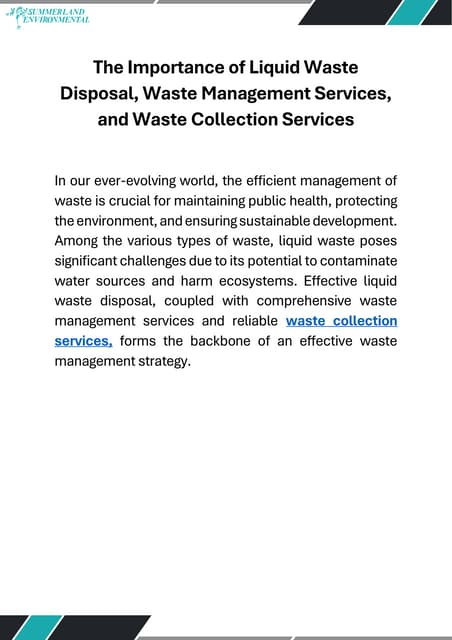The Best Strategy To Use For Reclaim Waste
The Best Strategy To Use For Reclaim Waste
Blog Article
Unknown Facts About Reclaim Waste
Table of ContentsReclaim Waste - The FactsHow Reclaim Waste can Save You Time, Stress, and Money.Unknown Facts About Reclaim WasteThe Best Guide To Reclaim WasteThe Ultimate Guide To Reclaim Waste
Residential sewage waste refers to the waste and items from a domestic septic tank. The appropriate management and disposal of domestic sewage waste require liquid waste to be transferred to a sewer treatment plant where the appropriate methods and devices are used to cleanse and dispose of waste.
Commercial waste typically includes possible hazards, such as flammable materials or a combination of fluid and strong waste products, and needs an advanced and thorough disposal process. The disposal of commercial waste generally entails the purification of waste before transportation to ensure risk-free and proper disposal. Industrial waste is created from by-products and drainage of industrial processes and manufacturing.
This sort of waste can not utilize the same sewer administration transportation or processes as septic or business liquids. The industrial waste management procedure requires the evaluation and testing of liquid waste before it undergoes the disposal process (industrial wastewater treatment). Drainage waste is the liquid waste that comes from drainage and excess stormwater in highly inhabited locations or cities
Drainage waste can trigger contamination and flooding if not handled properly. Find out more about drain cleaning and waste administration. Guaranteeing appropriate waste monitoring can protect against catastrophes and lower ecological harm. Both individuals in property settings and experts in commercial or manufacturing industries can profit from understanding the procedures and regulations of liquid waste monitoring.
The Single Strategy To Use For Reclaim Waste
Contact PROS Solutions today to find out about our waste administration and disposal solutions and the appropriate means to care for the fluid waste you generate.
(https://reclaimwaste1.mystrikingly.com/blog/efficient-liquid-waste-disposal-in-melbourne-why-reclaim-waste-is-your-go-to)Do you recognize what takes place to your water when you draw the plug, purge the commode or drain pipes the washing machine? No? Well, it deserves understanding. This so-called 'wastewater' is not just a crucial source however, after therapy, will certainly be released to our land, waterways or the sea. Utilized water from commodes, showers, bathrooms, cooking area sinks, washings and industrial procedures is referred to as wastewater.

water used to cool down machinery or tidy plant and equipment). Stormwater, a type of wastewater, is drainage that streams from farming and urban locations such as roof coverings, parks, yards, roadways, courses and seamless gutters right into stormwater drains, after rain. Stormwater streams without treatment directly to regional creeks or rivers, ultimately getting to the ocean.
The Ultimate Guide To Reclaim Waste
In Queensland, a lot of wastewater is dealt with at sewer therapy plants. Wastewater is transferred from domestic or commercial websites with a system of sewers and pump stations, recognized as sewerage reticulation, to a sewer therapy plant.
The Department of Natural Resources suggests city governments about managing, operating and preserving sewage systems and treatment plants. In unsewered locations, neighborhood governments might call for homeowners to mount specific or household sewer therapy systems to deal with domestic wastewater from bathrooms, kitchen areas, washrooms and washings. The Department of Natural Resources authorizes making use of family systems when they are shown to be efficient.
In some new subdivisions, therapy of some stormwater to eliminate trash, sand and gravel has actually begun utilizing gross pollutant traps. Wastewater therapy happens in four stages: Gets rid of solid matter.
Wastewater then streams right into large storage tanks where solids settle and are gotten rid of as sludge. Grease and residue are skimmed from the surface. Utilizes tiny living organisms referred to as micro-organisms to break down and remove remaining liquified wastes and fine particles. Micro-organisms and wastes are included in the sludge. Eliminates nitrogen and phosphorus nutrients that can cause algal flowers in our rivers and endanger aquatic life.
A Biased View of Reclaim Waste
Nutrient elimination is not available at all sewer therapy plants because it calls for pricey specialized tools. Clear fluid effluent produced after therapy might still web have disease-causing micro-organisms - liquid waste disposal.

Most wastewater flows into the sewerage system. Under the Act, regional governments provide approvals and licences for environmentally relevant activities (ERAs) entailing wastewater launches that may have a regional influence.
Reclaim Waste Things To Know Before You Get This
Monitoring supplies factual information about water high quality and can verify that permit conditions are being met. The information gotten via monitoring provides the basis for making water quality decisions.
Report this page